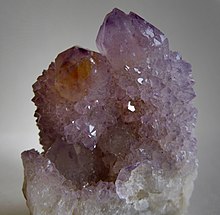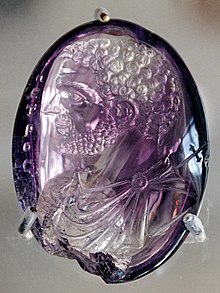amethyst
| amethyst | |
|---|---|
| Part of an amethyst druse | |
| General and classification | |
| chemical formula | SiO 2 + (Al, Fe, Ca, Mg, Li, Na) |
|
Mineral class (and possibly department) |
Oxides; Metal to oxygen = 1: 2 |
|
System no. to Strunz and to Dana |
see quartz see quartz |
| Similar minerals | other quartz varieties, ametrine |
| Crystallographic Data | |
| Crystal system | trigonal |
| Crystal class ; symbol | trigonal trapezoidal; 32 |
| Physical Properties | |
| Mohs hardness | 7th |
| Density (g / cm 3 ) | 2.65 |
| Cleavage | no |
| Break ; Tenacity | shell-like, brittle |
| colour | Violet, partly blotchy-cloudy, also zonal color distribution (colorless-violet) |
| Line color | White |
| transparency | transparent to translucent |
| shine | Glass to greasy gloss |
| Crystal optics | |
| Refractive indices |
n ω = 1.5442 n ε = 1.5533 |
| Birefringence | δ = 0.0091 |
| Optical character | uniaxial positive |
| Axis angle | 2V = 0 to 10 ° (0.013) |
| Pleochroism | very faint, violet and gray-violet, rarely also distinctly violet and lighter cobalt blue (with a violet tinge) |
| Other properties | |
| Chemical behavior | is etched by hydrofluoric acid (HF) |
| Special features | weak, greenish fluorescence |
Amethyst is the purple variety of the mineral quartz (SiO 2 ).
Etymology and history
The origin of the name from the Greek ἀμέθυστος (amethystos) - "counteracting the intoxication" - expresses the old belief that a wearer of amethyst is immune to the intoxicating effects of wine . Likewise, wine from an amethyst goblet should not make you drunk. Originally, this (but) belief resulted from the custom of diluting (red) wine with water, which then took on a reddish-purple (amethyst-colored) color. At the same time you could drink a lot more of it without getting drunk or even suffering a hangover .
Another variant of the naming is that Bacchus , the god of wine, frightened a young girl so that she froze to crystal. At this the god sighed, and when his breath touched the stone, he colored it purple like the color of wine.
The amethyst was also said to have an apotropaic effect against theft . This fact is proven by early historical grave finds. Merovingian tombs with amethyst show, if at all, traces of robbery not in the area where the stones were laid (necklace), even if gold pendants were also found here. Possibly in this epoch of early history there was a further (and today no longer reconstructable) said (negative) effect of the amethyst on the thief.
colour
The purple color of the amethyst ranges from a very light, slightly pink to a very dark purple.
The distribution of color in the crystal is usually irregular. Sectors of the crystal that are parallel to the main rhombohedron {10-11} are usually more intensely colored . There the purple color is concentrated in thin dark purple bands parallel to the {10-11} and more rarely {01-11} areas.
In these sectors, amethysts have an irregular, fine-lamellar twinning according to the Brazilian law and the intensely colored levels mark these twin levels.
Lattice defects with an Fe 4+ ion in tetrahedral coordination give the color . H. surrounded by four oxygen ions , so-called [FeO 4 ] centers . It is still controversial whether these defects occur on the silicon position (Fe 4+ replaces Si 4+ ) or on interstitial spaces (Fe 4+ in a normally empty tetrahedral gap in one of the six-sided channels of the quartz structure ).
These defects arise from defects with Fe 3+ in a tetrahedral gap through irradiation (e.g. from radioactive decay). This radiation removes an electron from the Fe ion and thus ionizes Fe 3+ to Fe 4+ . The radiation dose necessary to produce the amethyst color is z. B. in granitic rocks produced by the decay of the naturally occurring 40 K isotope in about six million years.
Amethysts can also be created from colorless iron-containing quartz by irradiation with gamma radiation.
Amethysts lose their color quickly under the influence of UV rays (e.g. from sunlight).
Amethysts also lose their color when heated. They mostly develop a citrine color , caused by submicroscopic iron oxide mixtures , and less often a green prasiolite color or become completely colorless.
Education and Locations

Amethyst is a common variety of quartz; large and clear specimens that are suitable for processing as gemstones are limited to comparatively few sites. It occurs in Brazil , Uruguay , Namibia, Madagascar , Russia , Sri Lanka and Morocco . Such crystals are found mainly in cavities in hydrothermal veins and in volcanic rocks. So-called amethyst drusen , in which the crystals have formed within a cavity, surrounded by a layer of chalcedony , are also frequently found in the trade . The most beautiful Druze usually come from Brazil and can be several meters high and weigh tons.
A well-known German site is the Steinkaulenberg gemstone mine in Idar-Oberstein . The unique and well-known blue-violet color is given there by the metals in the mountain range. After huge deposits were found in Brazil and these crystals can also be colored, mining in the Steinkaulenberg was stopped. Mineral mining is now prohibited there. The site can be viewed as a show mine.
Europe's largest amethyst deposit is located in the Lower Austrian city of Maissau . The site of the Amethyst from Maissau, discovered about 150 years ago, is located about 60 km northwest of Vienna, 1 km after the village of Maissau on Horner Strasse in the direction of Horn. The deposit in Maissau has a secured course of approx. 400 m, of which approx. 40 m is accessible in the open-air gallery, shows a maximum width of 2 m and is almost vertical (dip between 80 and 90 ° after SSW or NNE). The first targeted excavations took place in 1986 under the supervision of the Krahuletz Museum Eggenburg. In 1999 the Maissau Amethyst Society (MAG) began to systematically uncover the corridor. This impressive disclosure of an amethyst corridor in the Amethystwelt Maissau is unique worldwide. In addition, a continuation of the corridor for a distance of 1 km can be assumed.
Another rich occurrence of amethyst has been known since the 19th century in the area around the Eggenburg cemetery . Already Johann Krahuletz was valuable finds working here.
The visitable Lampivaara amethyst mine is located in the Pyhä Luosto National Park in northern Finland .
Use as a gem stone
Amethyst gem quality is a popular and widespread gemstone , which for trade, either in different faceted shapes ( Brillant , turnip , Briolett ) or smooth as Cabochon ground is.
Dark purple stones are considered particularly valuable. In addition, the varieties ametrine (combination of amethyst and citrine in one stone) or the opaque variety amethyst quartz with violet and white bands are valued as gemstones.
Manipulations, imitations and syntheses
Through burning Amethyst (about 400 ° C) creates the yellow to golden color of the variety citrine . Many of the “gold or Madeira topazes ” sold in the gemstone trade, which is misleading, are actually burnt amethysts. In the case of some amethysts, the firing also produces a greenish hue similar to the prasiolite , as which the fired amethyst is then also sold. Sometimes the color disappears completely in the flame and white quartz remains.
Fired stones usually get significantly more cracks and cracks, which are noticeable due to their sheen. Often the crystal tips and surfaces burst. As a rule, only low-quality amethysts are burned in order to "upgrade" them. This is a processing through which the color is changed using methods that are identical in nature and do not change any essential properties. Unburned citrine is usually only lightly colored and, as a rough stone, always has a long, rock-crystal-like shape. Citrine does not form drusen and is also a lot rarer than amethyst. Fired precious and semi-precious stones do not have to be declared as fired if a permanent change in color is caused.
A cheap, albeit not very durable, method of adding color to amethyst is to treat it with colored wax , as amethyst, unlike agate, can only be colored superficially.
Since the 20th century , syntheses of various gemstones, including the amethyst, have been produced, which can be distinguished from natural amethysts using gemological and mineralogical investigation methods, as they have structural deviations compared to the natural stone.
For fashion jewelry , the amethyst is imitated by violet glass or offered in composite form as a doublet .
Esoteric
Hildegard von Bingen (1098–1179) already described in her “Book of Stones” the use of amethyst as a healing stone against diseases such as skin impurities and swellings, but also against insect, spider and snake bites and against lice.
In esoteric circles , the amethyst is also used as a healing stone in gemstone therapy to support against alcoholism and other addictions. In addition, it is said to have cleansing, inspiring and insightful properties through its influence on the brow chakra . Scientific evidence of such effects does not yet exist, even though occasional healing successes have been recorded, which are, however, attributed to the placebo effect .
Amethyst drusen are also often used for so-called " energetic cleaning" and "charging" other healing stones.
As a zodiac stone , the amethyst is assigned to the zodiac sign Pisces , according to other sources the zodiac sign Sagittarius or Capricorn . As a planetary stone, it is assigned to the planet Neptune (Uyldert 1983, Raphaell 1987) or Pluto (Richardson / Huett 1989). The poet Theodor Körner assigns the amethyst in his poem The Monthly Stones to the month of February . In addition, according to a publication from 1985, the mineral stands for Thursday .
See also
literature
- August Nies: Amethystus . In: Paulys Realencyclopadie der classischen Antiquity Science (RE). Volume I, 2, Stuttgart 1894, Sp. 1828.
- Walter Schumann: Precious stones and gemstones. All species and varieties in the world. 1600 unique pieces . 13th revised and expanded edition. BLV Verlags-GmbH., Munich et al. 2002, ISBN 3-405-16332-3 , p. 134 (amethyst and amethyst quartz) .
- George R. Rossman: The Colored Varieties of the Silica Minerals . In: Peter J. Heaney, Charles T. Prewitt, Gerald V. Gibbs (Eds.): Silica. Physical Behavior, Geochemistry and Materials Applications (= Reviews in Mineralogy . Volume 29 ). Mineralogical Society of America, Washington, DC 1994, ISBN 0-939950-35-9 , pp. 433-468 (English).
Web links
- Mineral Atlas: Amethyst (Wiki)
- www.wissen-im-Netz.info: Mineralienlexikon - Amethyst ( Memento from November 11, 2017 in the Internet Archive )
Individual evidence
- ↑ a b c Bernhard Bruder: Decorated stones. Recognizing imitations and manipulations in gemstones and minerals . Neue Erde, Saarbrücken 1998, ISBN 3-89060-025-5 .
- ↑ Hildegard von Bingen: The book of the stones . Translated from the sources and explained by Peter Riethe . 4th edition. Müller, Salzburg 2006, ISBN 3-7013-0946-9 , pp. 98–100 ( excerpt from narayana-verlag.de [PDF; 201 kB ; accessed on August 23, 2019]).
- ↑ wissen-im-Netz.info: Hildegard of Bingen to curative effect of amethyst ( Memento of 3 May 2018 Internet Archive )
- ↑ Heilstein Guide - Amethyst ( Memento from April 21, 2018 in the Internet Archive )
- ^ Walter Schumann: Precious stones and gemstones. All kinds and varieties. 1900 unique pieces . 16th revised edition. BLV Verlag, Munich 2014, ISBN 978-3-8354-1171-5 , pp. 287-289 .
- ^ Walter Schumann: Precious stones and gemstones. All kinds and varieties. 1900 unique pieces . 16th revised edition. BLV Verlag, Munich 2014, ISBN 978-3-8354-1171-5 , pp. 284-286 .




